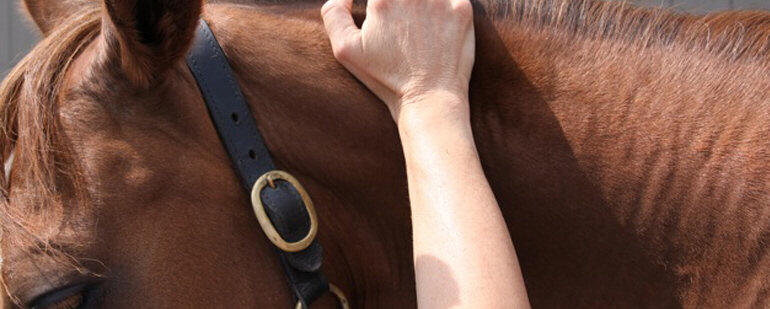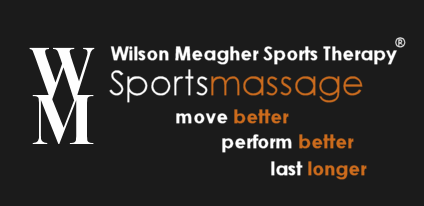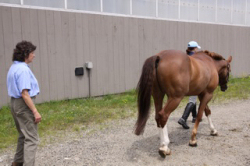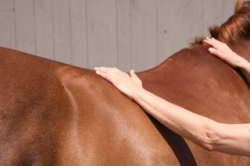|
 |
CASE STUDY: MOTION PROBLEM, CAUSE AND SOLUTIONAll horses move the same, no matter what discipline. Dressage, jumping, reining, racing, trail riding, all require the horse to bend, flex, extend, and rotate. Each discipline may emphasize one movement more than another which creates more stress and muscle tightness in specific areas of the horses body as a result of that discipline. Problem: Cold back. Hollowing of back, with head carried high. Loss of forward motion at the canter. I was called by Sally, a new client, who asked if I would work on her 6yo horse who seemed to “be cold backed” as she explained. “When I sit on him, he hollows his back, throws his head up, and is reluctant to go forward at the canter”. Sally’s vet assessed the horse and after a complete exam, involving flexion of his hocks and ankles, the vet decided to put the horse on a muscle relaxer for his back tightness. The vet diagnosed the horse with a sore back. If the muscle relaxer doesn’t work, the horse may have to have a nuclear scan, stated Sally.
I explained to Sally that when I can fairly
easily restore the back muscle to being soft and pliable by eliminating
the muscle tightness, this suggests that the cause of the back tightness
is from something external. By external, I mean the tightness was caused
by something outside of the horse’s body, not due to a spinal problem,
injury, painful joints or feet etc.
I then asked Sally to show me the saddle pad she used. Sally brought out two saddle pads and a ¼ inch square inch dense foam pad. Not one pad but essentially three! I held the pads and the foam pads together and found that by compressing them together, they measured about an inch in thickness. I then showed Sally that there was no space between the saddle and the back of the horse, when the saddle was placed on the back without the pads. The two pads and the dense foam pad were too thick to fit under this particular saddle, causing too much pressure on the horse’s back. There was not enough space between the saddle and the horse’s back to accommodate this thickness. Thus the pads were creating too much pressure, resulting in pain, and tightness in the back. Sally had her horse’s best interests in mind and said she used two pads and a foam pad to protect the back because she didn’t want it to become sore. I explained that this is a common situation and is similar to a person wearing too many socks in their shoes, or, too thick of a sock in their shoe. Within an hour, or over the course of the day, the person’s feet will be sore, cramped and uncomfortable. In summary, every problem has a cause! Fortunately this back soreness was relieved by a simple solution for a simple cause. Make sure that you don’t use too many pads if the saddle fit cannot accommodate the thickness of the pad or pads. Too much pressure in the back leads to discomfort, tightness, and ultimately, compromises the ease and freedom of movement in the horse. (For more info on back tightness see: “ Relieving Back Tightness” by Jo-Ann Wilson Practical Horseman. April 2010 and to learn a technique to relieve and prevent back tightness check out my DVD: “A Course in Equine Sportsmassage”. |
 |


 When
I met Sally and her horse, I asked if she could walk her horse in a
straight line back and forth in front of me. The horse did not step
underneath his body with his hind legs, appearing to lack any power to
his stride. He walked like a person with a sore back. Using palpation, I
found that the horse had a very tight back from behind his withers to
where the back of the saddle ends on his back. The tightness was equal
on both sides of the back. Upon this discovery, I immediately thought I
found a simple cause for the cold back as reported by Sally.
When
I met Sally and her horse, I asked if she could walk her horse in a
straight line back and forth in front of me. The horse did not step
underneath his body with his hind legs, appearing to lack any power to
his stride. He walked like a person with a sore back. Using palpation, I
found that the horse had a very tight back from behind his withers to
where the back of the saddle ends on his back. The tightness was equal
on both sides of the back. Upon this discovery, I immediately thought I
found a simple cause for the cold back as reported by Sally.  In
other words, the tightness did not come from the horse, but from
something happening to the horse. I asked Sally to show me her saddle
and all the saddle pads she rides the horse with. I held the saddle in
such a way so that I could view the gullet and examine the panels on
each side of the saddle. The saddle appeared balanced and evenly
stuffed. I then asked Sally to put the saddle on the horse’s back
without any pads. I wanted to see if Sally was positioning the saddle
correctly on the horse’s back. She placed the saddle correctly, behind
the shoulder to allow the shoulder to move freely. I noticed by looking
at the front of the saddle just behind the withers that the saddle fit
snuggly against the horse’s back. The saddle itself did not pinch the
back, but it did not allow any room for even a finger to be placed
between the saddle and the body of the horse.
In
other words, the tightness did not come from the horse, but from
something happening to the horse. I asked Sally to show me her saddle
and all the saddle pads she rides the horse with. I held the saddle in
such a way so that I could view the gullet and examine the panels on
each side of the saddle. The saddle appeared balanced and evenly
stuffed. I then asked Sally to put the saddle on the horse’s back
without any pads. I wanted to see if Sally was positioning the saddle
correctly on the horse’s back. She placed the saddle correctly, behind
the shoulder to allow the shoulder to move freely. I noticed by looking
at the front of the saddle just behind the withers that the saddle fit
snuggly against the horse’s back. The saddle itself did not pinch the
back, but it did not allow any room for even a finger to be placed
between the saddle and the body of the horse.